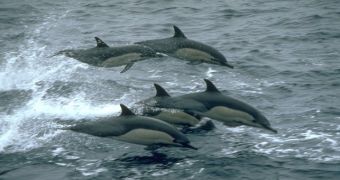Dolphins are considered the fastest sea mammals. Smaller dolphins reach 35-40 km (22-25 mi) per hour, but the orca or killer whale, that is in fact the world's largest dolphin, reaches 54 km (33 mi) per hour, which is a lot in the water. The question is: why not faster? The answer is given by a new research published in the "Journal of the Royal Society Interface" and carried out by a team from the Israel Institute of Technology in Haifa made of Gil Iosilevskii and Danny Weihs: it hurts.
The team made calculations of top speed of rapidly swimming fish like tuna, mackerel and dolphins based on models of the tail and fins. The smaller mackerel fish was limited by its muscle power, but the larger ones were not.
"There are certain limits on swimming speed that are imposed irrespective of power," Iosilevskii told New Scientist.
One limitation for the large sea creatures is the frequency at which they can beat their Tails for propelling; another limitation is the emergence of microscopic bubbles around the tail ("cavitation").
Cetaceans like dolphins have sensors in their tails and cavitation appears to be their main limiting factor.
Cavitation is caused by the pressure difference triggered by the movement of the fins (like the bubble ribbons left behind a ship's propeller). The collapse of these bubbles provokes a Shockwave. In ships, this affects the metal of the propellers, while for the dolphins, it hurts.
The team calculated that at depths of 0-5 m (0-17 ft), painful cavitations install when dolphins reach 10 to 15 m per second (36 to 54 km per hour or 22 to 33 mi per hour).
Fish like tuna have tails made of "bony" radii devoid of sensors, and this explains why tuna bypass dolphins in speed contests. The lack of pain sensitivity to cavitation is proved by their typical lesions provoked by cavitation. But cavitation does decrease speed: the collapsing bubbles break the water flow over the tuna's body, holding it. The cavitation phenomenon loses importance at greater depths because of the higher water pressure.
"Either way, reports of dolphins overtaking speed boats are likely to be a result of the dolphins "cheating" by surfing the bow waves," said Iosilevskii.
Perhaps this is also the reason why dolphins make their spectacular breaches: for increasing speed without pain.

 14 DAY TRIAL //
14 DAY TRIAL //